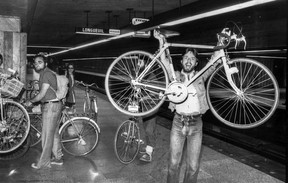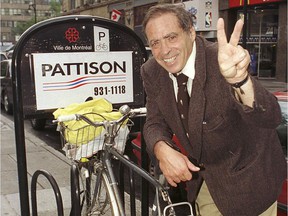Robert Silverman co-founded Le Monde à bicyclette, a rag-tag group of activists. The movement went on to transform Montreal into a cycling mecca.

Article content
Long before cycle paths criss-crossed Montreal — and before most people even thought of the bicycle as a means of transportation — there was “Bicycle Bob.”
advertisement
This advertisement has not loaded yet, but your article continues below.
Article content
In 1975, Robert Silverman co-founded Le Monde à bicyclette, a rag-tag group of activists on two wheels.
Using street theater and die-ins to dramatize the plight of urban cyclists, he and others launched what Silverman termed a “vélorution” — a bike revolution.
The movement went on to transform Montreal into the cycling mecca it is today, boasting Bixis, the Tour de l’île and more than 860 kilometers of bike paths.
“History has proven him right,” said Jacques Desjardins, 67, another co-founder of the Le Monde à bicyclette movement.
“He was ahead of everybody.”
Silverman died Sunday afternoon at age 87 in Ste-Agathe-des-Monts, his friend Richard Wutzky announced on Facebook.
Little in Silverman’s family background pointed to his future as the prophet of the cycling revolution.
advertisement
This advertisement has not loaded yet, but your article continues below.
Article content

He was born Nov. 30, 1934, to Florence and Bert Silverman, a prosperous insurance agent, and raised in Snowdon. He attended the High School of Montreal and Sir George Williams College (now Concordia University), but did not earn a degree.
At 25, with financial help from his father, he launched the Seven Steps bookshop in an old row house at 1430 Stanley St. Near Sir George Williams and popular Stanley St. cafés like the Pam-Pam, Riviera and Carmen’s, it attracted an eclectic clientele of students, literati and oddballs.
The venue later became the PotPourri, where a young Bob Dylan played his first Montreal gig in 1962, and still later the Rainbow Bar and Grill.
The goatee Silverman, a devoted Trotskyite, had no interest in making money. His efforts by him to evade the accountant his father had hired to oversee the bookshop’s finances was a daily game of cat and mouse, recalled the late Nick Auf der Maur, a Montreal city councilor and Gazette columnist who worked at Seven Steps as an 18- year-old.
advertisement
This advertisement has not loaded yet, but your article continues below.
Article content
“Every morning I opened the shop, and every morning Silverman would show up, open the door, peek in and whisper hoarsely: ‘Is my accountant here?’” recounted Auf der Maur in a 1981 column. The accountant would take Silverman to task for loaning books to customers instead of selling them — a practice that eventually resulted in the store’s bankruptcy, remembered Auf der Maur, who died in 1998.
One evening, the luckless accountant was working alone in the shop when he looked up to find himself face to face with a live python dangling from a light fixture, recalled Robert Landori, for whose firm the accountant worked. Silverman had bought the snake from some stevedores who found it in a load of bananas and it had escaped from its basket.
advertisement
This advertisement has not loaded yet, but your article continues below.
Article content

In 1962, Silverman moved to Cuba, where he met Argentine revolutionary Che Guevara on a sugar cane picking excursion and earned his living doing translation and teaching English. But he ran foul of the Castro regime for trying to bring anti-Soviet literature into the country and was deported two years later.
He had married Edith Rosenkranz in 1961, but the couple split after the return from Cuba. Edith was later killed in a car accident in France, a tragedy that affected Silverman deeply. A second marriage also ended in divorce.
Back in Montreal, he drove a cab for a time, taking off again to live on a kibbutz in Israel in 1967. He later knocked around Europe, where he rediscovered the bicycle while studying in France.
advertisement
This advertisement has not loaded yet, but your article continues below.
Article content
Of all of his passions — Marxism, nuclear disarmament, the anti-Vietnam War protest movement, volleyball, Palestinian rights and eye exercises to improve vision — it was in cycling that he found himself.
“Killed by a car, reborn by a bike: That’s the story of my life,” Silverman wrote in a one-line poem titled A Reason to Live.
Bicycles soared in popularity in the late 1960s and 1970s, spurred by the youth counterculture, environmental movement and availability of imported 10-speed bikes. But cycling in Montreal meant taking your life in your hands. From 1966 to 1976, an average of 68 cyclists were killed annually in Quebec, with 86 cycling deaths in 1974 alone.
(In contrast, between eight and 11 cyclists were killed each year from 2014-2019 despite a huge increase in cyclists, who numbered 4.2 million in 2015, according to the Société de l’assurance automobile du Québec.)
advertisement
This advertisement has not loaded yet, but your article continues below.
Article content

In the winter of 1974-75, Silverman co-founded Citizens on Cycles—known in French as Le Monde à bicyclette—at his apartment on Esplanade Ave. overlooking Jeanne Mance Park. But I have realized the movement needed to grow beyond its initial circle of anglophone activists in the neighborhood around the Main.
At that time, the Fédération québécoise de cyclotourisme — now known as Vélo-Québec — was focused on cycling as a recreational activity, Desjardins said. The 22-year-old Desjardins penned an article in the federation’s newsletter arguing that bikes should be treated as a means of transportation in their own right.
“Bob read that article. In March or April 1975, he called me at home. He said, ‘Come to a meeting!’”
advertisement
This advertisement has not loaded yet, but your article continues below.
Article content
The group that assembled that May at Silverman’s apartment was an unlikely mix of English-speaking leftists and young, francophone sovereignists, Desjardins said.
“We didn’t speak the same language. It was the Martians meeting the Earthlings,” he said.
“But we all wanted the same thing. It was a complete meeting of the minds.”
Le Monde à bicyclette was Canada’s first major urban cycling advocacy organization.
Silverman created a unique vocabulary to express the “cyclo-frustration” of living in an “auto-cracy” without bike paths, a bike route to the South Shore or the right to take a bike on the métro.
With Claire Morisette, a pillar of the group who died in 2007, Silverman put cycling on the civic agenda. “Robert was the thinker and Claire was the doer,” Desjardins said.
advertisement
This advertisement has not loaded yet, but your article continues below.
Article content
The cycling lobby group grabbed headlines by staging “cyclo-dramas,” where Silverman dressed up as Moses trying to part the waters of the St. Lawrence so bikes could get across. Members painted clandestine cycle lanes in the dark of night — a stunt that earned Silverman three days in prison. They staged die-ins at downtown intersections, complete with ketchup-daubed victims and mangled bikes. They presented a bike to autocratic Major Jean Drapeau, who had spearheaded extensive highway construction during his nearly three decades in power. They hauled ladders and cardboard elephants on the métro to protest against the ban on bikes in the transit system. Silverman rolled out a carpet on de Maisonneuve Blvd. to press the group’s demand for an east-west bike path across downtown Montreal.
advertisement
This advertisement has not loaded yet, but your article continues below.
Article content
“He was the journalists’ darling,” Desjardins said. Behind his humor and flair for drama, Silverman was also the movement’s philosopher, he said, drawing inspiration from the writings of radical Austrian priest Ivan Illich, author of Energy and Equity, and American activist Saul Alinsky, author of Rules for Radicals: A Pragmatic First (1971).
“The bicycle is the epitome of freedom. It’s the perfect companion of a perfect urban world. It’s cheap, it’s healthy, it’s simple, it’s easily fixable. It breaks the radical monopoly of the car,” Silverman said in 1981.
The de Maisonneuve bike path, named in honor of Morissette, was finally built in 2007-08 — 15 years after Westmount created a cycle path on its portion of de Maisonneuve. Today, Montreal has more than 860 kilometers of bike paths. A cycle bridge near the Victoria Bridge opened in 1990. Bikes are now allowed in the first car of métro trains during off-peak hours.
The quintessential urban dweller, Silverman moved to Val-David in the Laurentians in the early 2000s.
His legacy is the enormous popularity of cycling in Montreal and its extensive network of bike paths, said John Symon, a cycling journalist who is writing a biography of Silverman.
“Montreal is rated as the No. 1 bicycling city in North America. In the 1970s, it was a pretty unlikely candidate for that,” he said.
-
History Through Our Eyes: Oct. 12, 1976, ‘Bicycle Bob’ Silverman
-
Cycling in Montreal: Q&A with pioneering activist Robert “Bicycle Bob” Silverman

